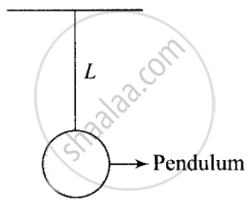Advertisements
Advertisements
प्रश्न
As the temperature is increased, the time period of a pendulum ______.
विकल्प
increases as its effective length increases even though its centre of mass still remains at the centre of the bob.
decreases as its effective length increases even though its centre of mass still remains at the centre of the bob.
increases as its effective length increases due to shifting of centre of mass below the centre of the bob.
decreases as its effective length remains same but the centre of mass shifts above the centre of the bob.
उत्तर
As the temperature is increased, the time period of a pendulum increases as its effective length increases even though its centre of mass still remains at the centre of the bob.
Explanation:
A pendulum clock keeps proper time at temperature θ0. If the temperature is increased to θ (> θ0), then due to linear expansion, the length of pendulum increases and hence its time period will increase

Let T = `2πsqrt(L_0/g)` at temperature θ0
And T' = `2πsqrt(L/g)` at temperature θ.
`T^'/T = sqrt(L^'/L)`
= `sqrt((L[1 + αΔθ])/L`
= `1 + 1/2 αΔθ`
Therefore change (loss or gain) in time per unit time lapsed is `(T^' - T)/T = 1/2 αΔθ`
Fractional change in time period `(ΔT)/T = 1/2 αΔθ`
So, as the temperature increases, the length of pendulum increases and hence time period of the pendulum increases. Due to an increment in its time period, a pendulum clock becomes slow in summer and will lose time.
APPEARS IN
संबंधित प्रश्न
The coefficient of volume expansion of glycerin is 49 × 10–5 K–1. What is the fractional change in its density for a 30 °C rise in temperature?
A 10 kW drilling machine is used to drill a bore in a small aluminium block of mass 8.0 kg. How much is the rise in temperature of the block in 2.5 minutes, assuming 50% of power is used up in heating the machine itself or lost to the surroundings Specific heat of aluminium = 0.91 J g–1 K–1
A system X is neither in thermal equilibrium with Y nor with Z. The systems Y and Z
Answer the following question.
Give an example of the disadvantages of thermal stress in practical use?
Solve the following problem.
In olden days, while laying the rails for trains, small gaps used to be left between the rail sections to allow for thermal expansion. Suppose the rails are laid at room temperature 27 °C. If maximum temperature in the region is 45 °C and the length of each rail section is 10 m, what should be the gap left given that α = 1.2 × 10–5K–1 for the material of the rail section?
An iron plate has a circular hole of a diameter 11 cm. Find the diameter of the hole when the plate is uniformly heated from 10° C to 90° C.`[alpha = 12 xx 10^-6//°"C"]`
A metal ball immersed in water weighs w1 at 0°C and w2 at 50°C. The coefficient of cubical expansion of metal is less than that of water. Then ______.
A disc is rotating freely about its axis. The percentage change in angular velocity of a disc if temperature decreases by 20°C is ______.
(coefficient of linear expansion of material of disc is 5 × 10-4/°C)
A clock with an iron pendulum keeps the correct time at 15°C. If the room temperature is 20°C, the error in seconds per day will be near ______.
(coefficient of linear expansion of iron is 1.2 × 10-5/°C)
A metal rod Y = 2 × 1012 dyne cm-2 of coefficient of linear expansion 1.6 × 10-5 per °C has its temperature raised by 20°C. The linear compressive stress to prevent the expansion of the rod is ______.
